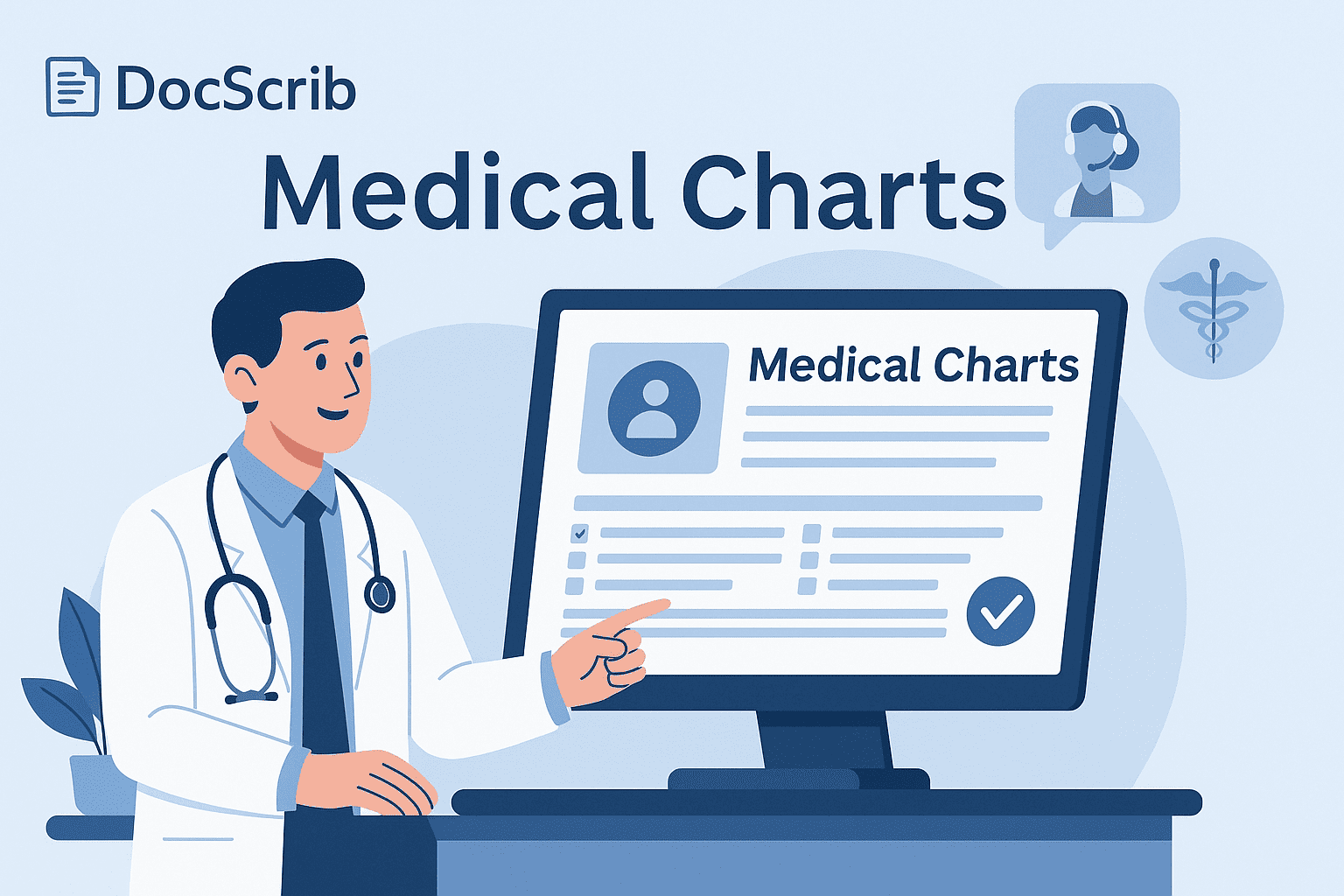Updated on: July 7, 2025
In the ever-demanding world of healthcare, accurate documentation is the backbone of quality patient care. At the heart of this documentation lie Medical Charts—the essential records that tell the story of each patient’s journey through the healthcare system.
As documentation requirements increase and the burden on providers grows, Virtual Medical Scribes and AI-powered tools like DocScrib are transforming the way medical charts are created, managed, and optimized.
In this guide, we’ll dive into:
-
What medical charts are and what they include
-
Why they are crucial for healthcare providers and patients
-
The challenges of traditional charting
-
How DocScrib’s AI-driven solutions can revolutionize your medical documentation process
What Are Medical Charts?
A medical chart is a comprehensive, organized collection of information about a patient’s medical history, treatment plans, and ongoing care. It is used by healthcare professionals to:
-
Track patient progress
-
Make informed clinical decisions
-
Ensure proper care coordination
-
Comply with legal, billing, and regulatory requirements
Medical charts are also sometimes referred to as:
-
Patient charts
-
Health records
-
Clinical documentation
-
Electronic Health Records (EHRs)
What Does a Medical Chart Typically Include?
A standard medical chart consists of various sections, such as:
| Section | Description |
|---|---|
| Patient Information | Demographics, contact details, insurance |
| Medical History | Past illnesses, surgeries, allergies, family history |
| Medications & Allergies | Current medications, known reactions |
| Progress Notes (SOAP Format) | Subjective, Objective, Assessment, Plan |
| Lab Results & Imaging | Test results, radiology, pathology reports |
| Care Plans & Follow-Up | Treatment recommendations, next steps |
👉 Many practices today manage these charts through EHR systems, which, while efficient, have introduced new challenges related to time, accuracy, and clinician burnout.
Why Are Medical Charts So Important?
Continuity of Care:
Medical charts ensure that any clinician accessing the record can understand the patient’s history and current needs.
Legal Protection:
Thorough documentation protects providers in case of disputes or audits.
Accurate Billing:
Medical charts play a key role in correct coding and reimbursement.
Patient Safety:
Accurate records help avoid medication errors and missed diagnoses.
The Challenges of Traditional Medical Charting
Despite their importance, maintaining medical charts comes with several pain points:
Time-Consuming:
Physicians spend an average of 1-2 hours daily on charting after clinical hours.
Burnout:
Documentation overload is one of the leading causes of physician burnout.
Human Error:
Inaccurate or incomplete charts can lead to clinical risks.
Costly Manual Scribing:
Hiring in-house scribes adds significant overhead.
How Virtual Medical Scribes & DocScrib Streamline Medical Charts
The rise of Virtual Medical Scribes and AI solutions like DocScrib is revolutionizing how medical charts are created and managed.
What is a Virtual Medical Scribe?
A Virtual Medical Scribe assists healthcare providers remotely by documenting patient encounters in real-time or asynchronously, entering the data directly into the EHR.
DocScrib’s AI-Powered Approach to Medical Charting
DocScrib combines AI-powered ambient listening, speech recognition, and natural language processing (NLP) to:
Listen passively during patient encounters
Generate structured medical charts in real-time
Deliver fully editable drafts for provider review
Integrate seamlessly with most EHR platforms
Ensure HIPAA compliance and data security
👉 Want to see how DocScrib can streamline your documentation?
Book a Free Demo Today
Key Benefits of AI-Enhanced Medical Charting
| Benefit | Impact |
|---|---|
| Faster Documentation | Complete charts in real-time or immediately post-visit |
| Reduced Clinician Burnout | Less after-hours work, more patient-facing time |
| Improved Chart Accuracy | AI minimizes omissions and standardizes formatting |
| Cost Savings | Eliminates the need for costly in-house scribes |
| Better Compliance | Supports accurate coding and billing practices |
Who Can Benefit from Smarter Medical Charting?
Primary Care Physicians & Specialists
Hospitals & Outpatient Clinics
Behavioral Health & Psychiatry Providers
Telemedicine Providers
Healthcare Consultants & Administrators
Whether you’re a solo practitioner or a large hospital network, DocScrib’s AI-powered Virtual Medical Scribes can be tailored to your needs.
Real-World Impact: A Case for DocScrib
Clinicians using DocScrib have reported:
-
Up to 70% reduction in charting time
-
Greater patient satisfaction due to improved provider presence
-
Enhanced billing accuracy and revenue cycle management
👉 Don’t just take our word for it—schedule your demo now and experience the DocScrib difference.
Final Thoughts: The Future of Medical Charts is Here
The days of tedious, time-consuming charting are over. With Virtual Medical Scribes and AI-powered solutions like DocScrib, clinicians can:
- Save time
- Reduce stress
- Improve accuracy
- Deliver better patient care
👉 Ready to upgrade your practice?
Book Your Free Consultation with DocScrib
